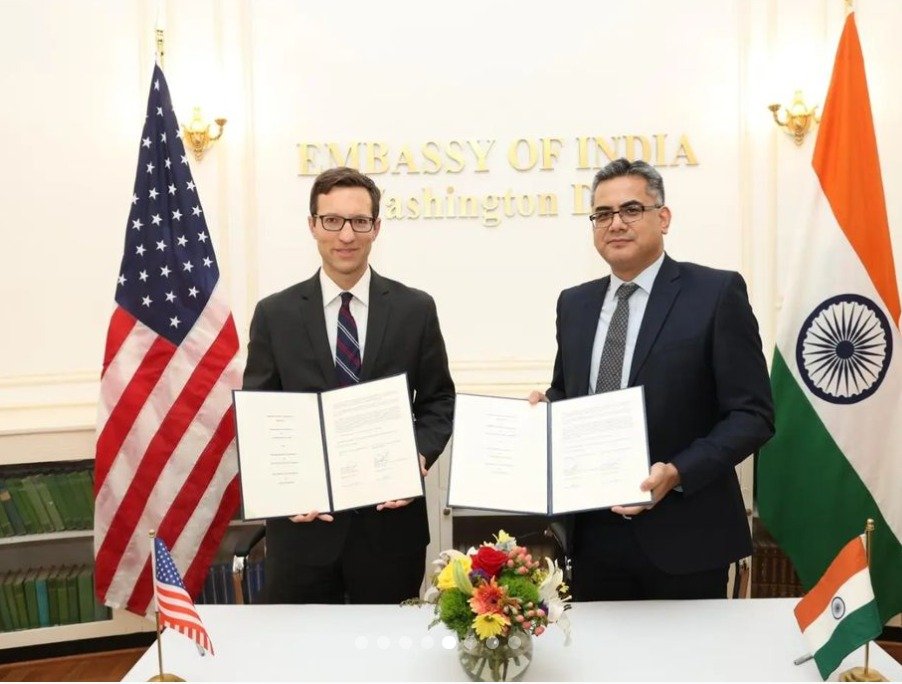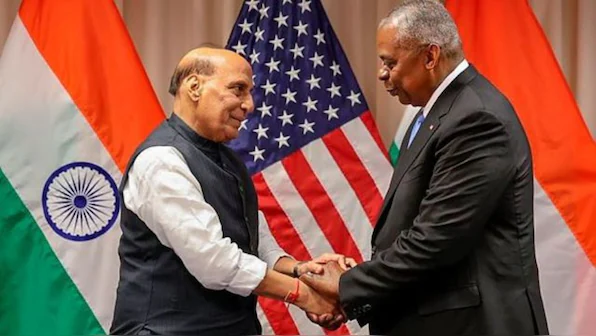In this world of unpredictability, India has a sure shot to a goal, which unwaveringly lies in its strategic autonomy in diplomacy and defence. Close on the heels of PM Modi’s first ever official trip to Poland and Ukraine, Defence Minister Rajnath Singh paid a four-day (August 23 to 27) visit to the US to bolster defence partnership between New Delhi and Washington DC.
Modi’s first ever visit to Poland (first by an Indian PM since 1979) and Ukraine (first since diplomatic ties were established in 1992) was aimed at sending a message to the West that India is really a peacemaker and that its criticism following the Indian PM’s visit to Russia was unjustified. Rajnath Singh’s official trip to the US confirmed that New Delhi wanted to infuse dynamism and confidence in its defence relationship with Washington DC, despite certain irritants which have recently developed between the two sides.
Invariably, peace and security have been major aspects of India’s approach to the world which is witnessing wars in Europe and West Asia and may see the eruption of a conflict anytime in the Indo-Pacific region, possibly in the South China Sea or the Taiwan Strait as the continued Chinese aggression shows.
Peace and security have been major aspects of India’s approach to the world which is witnessing wars in Europe and West Asia and may see the eruption of a conflict anytime in the Indo-Pacific region, too
Significance of India-US defence partnership
India’s defence partnership with the US assumes high significance. According to the US Department of Defence (DoD), in the past more than 15 years, the US has emerged as the key supplier of arms, accounting for 10% of the total defence exports to India.
A new thrust was added to the ongoing defence relationship between the two countries, when they signed two new foundational agreements: First, on Security of Supply Arrangement (SOSA) and second, on Assignment of Liaison Officers (ALO).
India earlier signed four foundational agreements with the US and they are: General Security of Military Information Agreement (GSOMIA), Logistic Support Agreement (LSA), Communications and Information Security Memorandum of Agreement (CISMOA) and the Basic Exchange and Cooperation Agreement for Geospatial Intelligence (BECA).
Foundational agreement like the SOSA, as per the US Department of Defence, “will enable the two countries to acquire the industrial resources they need from one another to resolve unanticipated supply chain disruptions to meet national security needs.” India is the 18 th SOSA partner of the US. Other SOSA partners include Australia, Canada, Italy, Spain, the UK, Sweden, Denmark, Estonia, Finland, Latvia, Lithuania, the Netherlands, Norway, Israel, Japan, South Korea, and Singapore.
The deployment of liaison officers by US and India will lead to enhanced operational coordination between the militaries of the two countries, especially in areas of mutual strategic interest such as maritime security and counterterrorism
It is not a legally binding agreement, but is said to be giving the US companies more freedom in widening their base in India in terms of manufacturing and sourcing products from the country.

Some experts say the SOSA will be a key factor in strengthening the US-India Defence Technology and Trade Initiative (DTTI) signed between the two countries in 2012.
India and the US which are negotiating about early conclusion of the Reciprocal Defence Procurement Agreement (RDP), a legally binding framework, which will be the next logical progression in the hallowed defence partnership between the two countries. It will add to
efforts for joint production and sourcing of large-scale high-end defence products. The RDP facilitates US-based companies to set up manufacturing bases in foreign countries.
However, it is India-US agreement on Assignment of Liaison Officers (ALO) which will set the ball rolling on military-to-military relations in terms of deployment of Indian armed forces officers in key strategic US Commands such as the Indo-Pacific Command (INDOPACOM) and the
Special Operations Command (SOCOM).
During Defence Minister Rajnath Singh’s talks with senior officials of the American defenc establishment, it is understood that Indian concerns on delay in the supply of engines for Tejas aircraft have been addressed
The deployment of liaison officers will lead to enhanced operational coordination between the militaries of India and the US, especially in areas of mutual strategic interest such as maritime security and counterterrorism. By establishing a direct link between India and the US defence formations, this initiative will improve the flow of information and foster greater trust, mutual understanding, and cooperation in joint military operations.
Focus on joint production
While these agreements will indeed mark a new phase in India-US defence partnership, yet what created a buzz in the complex world of defence armaments is the two countries’ decision to prioritise joint production of jet engines, unmanned platforms, munitions, and ground
mobility systems under the US-India Roadmap for Defence Industrial Cooperation.
Immediate joint production of GE F404 jet engines for which negotiations are on between General Electric (GE) Aerospace and Hindustan Aeronautics Limited (HAL), is required to stem any further delay in the delivery of LCA Tejas Mark-1A fighter jets to the IAF. As many as 83Mk-1A jets were ordered by the IAF.
The first such aircraft was to be delivered by March 31, 2024, but HAL failed to deliver it. The public sector aerospace and defence company, as per various media reports, will start delivery of the aircraft from November 2024 onwards. Yet, it is not sure whether this promise will be met. Unless the US-based GE Aerospace will begin supplying F404 engines to HAL, the issue of delivery of Mark-1 A fighter jets to the IAF would not materialise, say some experts.
However, following Defence Minister Rajnath Singh’s talks with his US counterpart Lloyd Austin, National Security Adviser Jake Sullivan, and other senior officials of the American defence establishment, it is understood that India’s concerns on delay in the supply of engines for Tejas aircraft have been addressed. Besides, an assurance has also been given in quickening the process of early joint production of GE F404 jet engines, which will power advanced versions of Tejas aircraft, Mk-II fighter jets.
Cornering high-end defence products
Procurement of 31 MQ-9B High-Altitude Long Endurance (HALE) UAVs was also discussed. In February 2024, the US had approved the sale of 31 MQ-9B armed drones to India at an estimated cost of $3.99 billion. Of the total 31 MQ-9B HALE UAVs, the Navy will get 15 SeaGurdian drones, while the Army and the IAF will get eight each of the land version -SkyGuardian.
Joint production of Stryker infantry combat vehicles and the Javelin Anti-Tank Guided Missiles (ATGMs) also featured in talks with American authorities during Rajnath Singh’s four-day visit to the US
Acquisition of these drones will bolster Indian armed forces’ surveillance capabilities against activities of Pakistan and China in the Indian Ocean and along the Line of Control (LoC) with Pakistan and the Line of Actual Control (LAC) with China. The unmanned UAV is designed to fly over the horizon via satellite for more than 40 hours in all weather conditions.
During Defence Minister Rajnath Singh’s visit, the US also approved the sale of $52.8 million anti-submarine warfare (ASW) sonobuoys and related equipment to India for the multi-role MH-60R Seahawk helicopters which are being inducted by the Navy to hunt hostile submarines.
A readout from the US Department of Defence said the Indian government has requested to buy AN/SSQ-53G high-altitude ASW sonobuoys, AN/SSQ-62F HAASW sonobuoys and AN/SSQ-36 sonobuoys as well as engineering, technical and logistics support. Packed with an advanced sonar system, sonobuoys help naval anti-submarine warfare (ASW) forces to track hostile submarines and subsequently hunt them with air-launched weapons.
Joint production of Stryker infantry combat vehicles and the Javelin Anti-Tank Guided Missiles (ATGMs) also featured in talks with American authorities during Rajnath Singh’s four-day visit to the US, where the Indian Defence Minister utilised time to interact with captains of the US defence industry.
A new chapter has been added to the evolving defence partnership between India and the US following Defence Minister Rajnath Singh’s visit to America, where both sides reiterated their call for a free and open Indo-Pacific region
In the presence of CEOs and other senior representatives of US defence and technology companies in Washington DC, Rajnath Singh highlighted the presence of a robust pro-FDI and pro-business ecosystem with a skilled human resources and large domestic market in India.
His trip to the Memphis-based William B Morgan Large Cavitation Channel (LCC) in the Naval Surface Warfare Centre (NSWC) showed that India also aims for having the same facility on its soil. LCC is one of the world’s largest and most technically-advanced water tunnel facilities for testing submarines, torpedoes, naval surface ships and propellers.
Overall, a new chapter has been added to the evolving defence partnership between India and the US following Defence Minister Rajnath Singh’s visit to America, where both sides reiterated their call for a free and open Indo-Pacific region.
—
– The writer is a senior journalist with wide experience in covering international affairs. The views expressed are of the writer and do not necessarily reflect the views of Raksha Anirveda
–The writer is a senior journalist with wide experience in covering international affairs. The views expressed are of the writer and do not necessarily reflect the views of Raksha Anirveda






